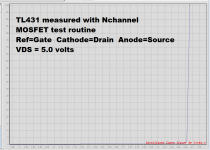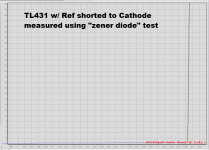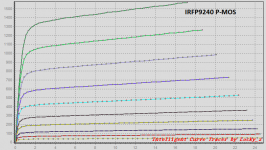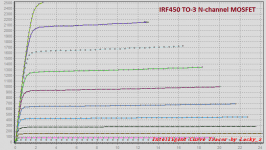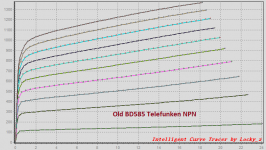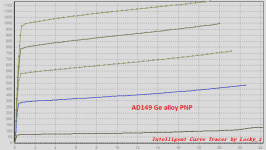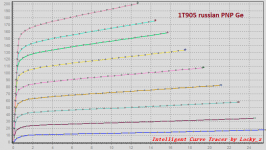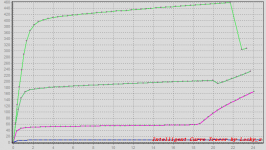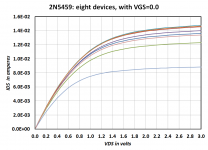Hi Mark, I just tried number one. But, OK, I see.
When I look at Locky's print from page one, he must have used a different setup. His vertical line consists of many, many dots.
When I look at Locky's print from page one, he must have used a different setup. His vertical line consists of many, many dots.
The two test procedures gave very similar results on my curve tracer just now. The same TL431 chip was used in both measurements.
_
Hi Mark, today I tried the zener way, and yes, it works as well here 🙂
Thanks again!
Cheers Ernst
Locky, (or anyone else),
I measured a whole bunch of fets in one sitting before i realized that the software only seems to allow you to export *one* curve at a time.
Is there a way to dump all the data from one measurement file into an excel in one go ?
I measured a whole bunch of fets in one sitting before i realized that the software only seems to allow you to export *one* curve at a time.
Is there a way to dump all the data from one measurement file into an excel in one go ?
My tracer arrived recently!
And I made inumerous measurements!
Worked flawlessy!
Some examples, in attachment:
And I made inumerous measurements!
Worked flawlessy!
Some examples, in attachment:
Attachments
-
 NPN-PNP combate 1.png24.4 KB · Views: 220
NPN-PNP combate 1.png24.4 KB · Views: 220 -
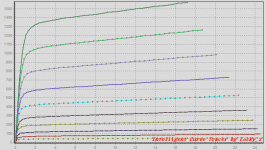 IRF9240 0V1 Vgpasso.png20.8 KB · Views: 187
IRF9240 0V1 Vgpasso.png20.8 KB · Views: 187 -
 IRF450.png21.2 KB · Views: 190
IRF450.png21.2 KB · Views: 190 -
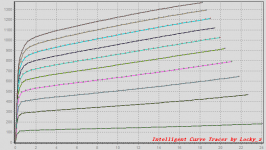 BD585.png22.4 KB · Views: 204
BD585.png22.4 KB · Views: 204 -
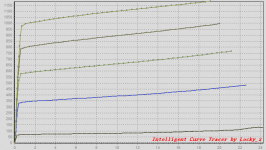 AD149.png19.4 KB · Views: 202
AD149.png19.4 KB · Views: 202 -
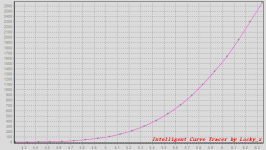 2SK2654 gm.png19 KB · Views: 223
2SK2654 gm.png19 KB · Views: 223 -
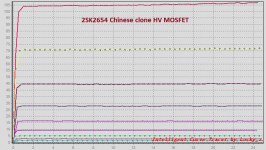 2SK2654 4V2-5Vgs.png20 KB · Views: 220
2SK2654 4V2-5Vgs.png20 KB · Views: 220 -
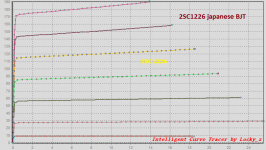 2SC1226.png20.4 KB · Views: 748
2SC1226.png20.4 KB · Views: 748 -
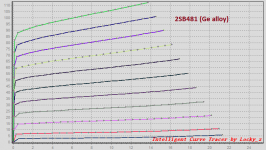 2SB481.png23.3 KB · Views: 746
2SB481.png23.3 KB · Views: 746 -
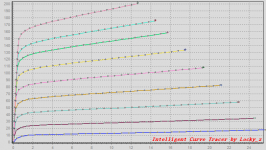 1T905.png21.3 KB · Views: 779
1T905.png21.3 KB · Views: 779
About crazy curves, I noted that the curves craze starts when we select a voltage impossible to obtain, like 36V with a 32Vsupply, or a low resistor for Rb and high for Rc, and manifests more in PNP/P-devices readings. In N devices, the curves only bunch to low values. With extreme wrong choosed parameters, the P-device curves become a fully mess.
Is easy to make a good reading, os onlya matter to make a little test before, and so choose the most correct resistors/Vc/Ve/Vb etc.
Oscillations perhaps I have only with this MOSFET (an IRF9610), and with a RF PNP. All other measurements worked without any trouble.
Is easy to make a good reading, os onlya matter to make a little test before, and so choose the most correct resistors/Vc/Ve/Vb etc.
Oscillations perhaps I have only with this MOSFET (an IRF9610), and with a RF PNP. All other measurements worked without any trouble.
Attachments
When you acquire one tracer unit, this goes with a software disc configured for the actual tracer circuit (calibrated).
If someone lost one, one can call the locky_z.
If someone lost one, one can call the locky_z.
Is it possible to get the software without that red text "Intelligent Curve Tracer by Locky_z" tag in the bottom right corner, find it disturbing and considering one paying dough for the product that would preferably be able to turn off.
Don't worry, you can't buy one -- he has ceased manufacturing and selling them for a while.
If you already own a used LockyZ curve tracer, you can export its raw XY data ("Save Data") to a file with suffix .cuv, which is ascii format. Then have your software department whiz together a little python code or perl script, that converts from .cuv format to the input format of your favorite plotting software (example: Excel .csv). Plot it there. Presto, any logo you wish goes in the bottom right corner. Or, no logo at all.
Attached below is an example where I took the LockyZ .cuv file, script processed it into an Excel .csv file, and then plotted it with Excel. Worked just fine.
_
If you already own a used LockyZ curve tracer, you can export its raw XY data ("Save Data") to a file with suffix .cuv, which is ascii format. Then have your software department whiz together a little python code or perl script, that converts from .cuv format to the input format of your favorite plotting software (example: Excel .csv). Plot it there. Presto, any logo you wish goes in the bottom right corner. Or, no logo at all.
Attached below is an example where I took the LockyZ .cuv file, script processed it into an Excel .csv file, and then plotted it with Excel. Worked just fine.
_
Attachments
This really looks nice!
As I also own one, I would be very happy if you could send it to me so I can use your script/program to get the data to excel!
As I also own one, I would be very happy if you could send it to me so I can use your script/program to get the data to excel!
I recently picked up one of Locky's curve tracers to test n-channel logic-level MOSFETs for use in a modified NTD1 I/V stage with the ES9038PRO. Here's the circuit diagram I'm working with:

The operating conditions of the MOSFETs in this circuit are:
Rail voltage: +/-6V
Voltage at source: 1.65V
Voltage at drain: ~3V
Vgs: ~1.35V
Current through each MOSFET: 1.09A
I'm interested in first testing several different devices to find the one with the highest transconductance at this operating point, and then later matching Vgs and transconductance among a batch of devices to find a quad to use in the final circuit.
I read through both curve tracer threads and believe I have a decent grasp on its operation, but I wanted to walk through my testing procedure to make sure I'm not making any mistakes and see if I've missed anything that would improve accuracy.
Here's an example curve from an IRL2203NS:

Load Conditions -> NMOS Vgs-Id(Fix Vce)
I selected RB=500 RC=5 since I'm looking for accuracy at a higher current of 1090mA, a constant Vce/Vds of 1.35V to match my operating condition, VB from 0 to 5 since Vgs won't ever go much beyond 3V, and checked "Calibration before measure".
Increasing the AD Sample should increase the accuracy of the measurement, but I wasn't sure where to set V Step. Since I'm looking at transconductance my thought was more data points along the curve would be helpful for calculating the slope, but I'm not positive that's correct or what the best balance of granularity is given the capabilities of the tracer. Locky at one point mentioned that the highest voltage resolution is 1-2 mV.
Once I had the curve, I selected the segment from roughly 900 to 1200 mA, right clicked, and selected "Vgs Calculate", which showed the transconductance to be 6898 mS:

Is this the most accurate and repeatable method of measuring transconductance across different devices? Should I just make sure I'm always selecting the same Id range each time I measure a new device?
Once I get to matching, my plan is to calculate the transconductance as above and then record Vgs at 1090mA, by right clicking, selecting "Id Sort", and entering 1090:

I can then export this data to a spreadsheet and sort to find matched pairs/quads based on high transconductance and close Vgs.
Let me know if all the above sounds correct and if I've missed anything.
Since these MOSFETs are D2PAK SMDs I'm using clips on the leads with wires going to the curve tracer screw terminals. I've added a 100R resistor in series with the gate to prevent oscillation, but I'm guessing in general I want to keep these wires as short as possible?
Has anyone upgraded the op amps or other components and found improved measurement accuracy? I'm considering swapping out the LM358s for LT1013s as recommended by Locky to improve Ve stability.

The operating conditions of the MOSFETs in this circuit are:
Rail voltage: +/-6V
Voltage at source: 1.65V
Voltage at drain: ~3V
Vgs: ~1.35V
Current through each MOSFET: 1.09A
I'm interested in first testing several different devices to find the one with the highest transconductance at this operating point, and then later matching Vgs and transconductance among a batch of devices to find a quad to use in the final circuit.
I read through both curve tracer threads and believe I have a decent grasp on its operation, but I wanted to walk through my testing procedure to make sure I'm not making any mistakes and see if I've missed anything that would improve accuracy.
Here's an example curve from an IRL2203NS:

Load Conditions -> NMOS Vgs-Id(Fix Vce)
I selected RB=500 RC=5 since I'm looking for accuracy at a higher current of 1090mA, a constant Vce/Vds of 1.35V to match my operating condition, VB from 0 to 5 since Vgs won't ever go much beyond 3V, and checked "Calibration before measure".
Increasing the AD Sample should increase the accuracy of the measurement, but I wasn't sure where to set V Step. Since I'm looking at transconductance my thought was more data points along the curve would be helpful for calculating the slope, but I'm not positive that's correct or what the best balance of granularity is given the capabilities of the tracer. Locky at one point mentioned that the highest voltage resolution is 1-2 mV.
Once I had the curve, I selected the segment from roughly 900 to 1200 mA, right clicked, and selected "Vgs Calculate", which showed the transconductance to be 6898 mS:

Is this the most accurate and repeatable method of measuring transconductance across different devices? Should I just make sure I'm always selecting the same Id range each time I measure a new device?
Once I get to matching, my plan is to calculate the transconductance as above and then record Vgs at 1090mA, by right clicking, selecting "Id Sort", and entering 1090:

I can then export this data to a spreadsheet and sort to find matched pairs/quads based on high transconductance and close Vgs.
Let me know if all the above sounds correct and if I've missed anything.
Since these MOSFETs are D2PAK SMDs I'm using clips on the leads with wires going to the curve tracer screw terminals. I've added a 100R resistor in series with the gate to prevent oscillation, but I'm guessing in general I want to keep these wires as short as possible?
Has anyone upgraded the op amps or other components and found improved measurement accuracy? I'm considering swapping out the LM358s for LT1013s as recommended by Locky to improve Ve stability.
Hi there,
could anybody send me the newest version of Locky_z's software, please? And has anybody the newest driver for the USB Version? I would be very pleased if anybody could share it.
Thank you!
Matthias
Edit:
I found the yahoo group and registered there. There I could download the version 3.5 of his software.
Now just the newest driver is missing.
could anybody send me the newest version of Locky_z's software, please? And has anybody the newest driver for the USB Version? I would be very pleased if anybody could share it.
Thank you!
Matthias
Edit:
I found the yahoo group and registered there. There I could download the version 3.5 of his software.
Now just the newest driver is missing.
Last edited:
OK, here now the link to the manufacturer of the chip, they'll always have the latest drivers. http://www.wch.cn/download/CH341SER_EXE.html
- Home
- Vendor's Bazaar
- Intelligent Curve Tracer 3.0 release
